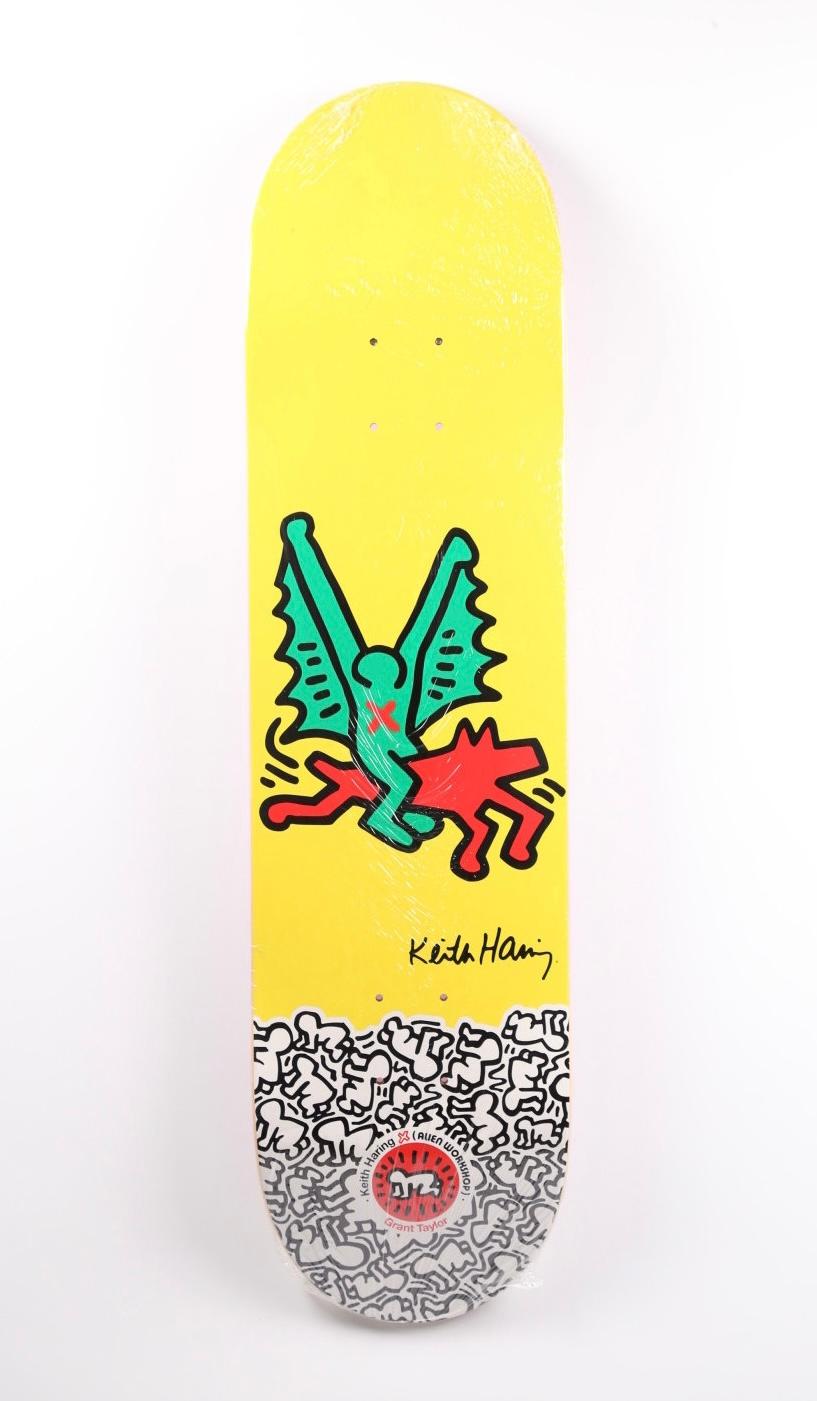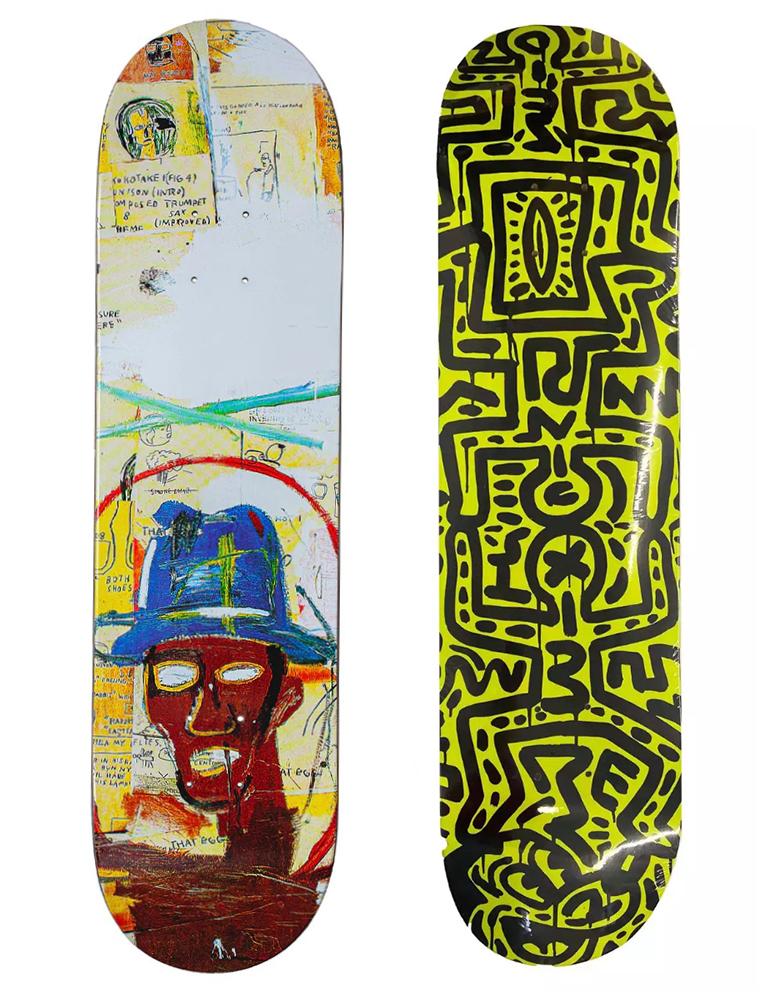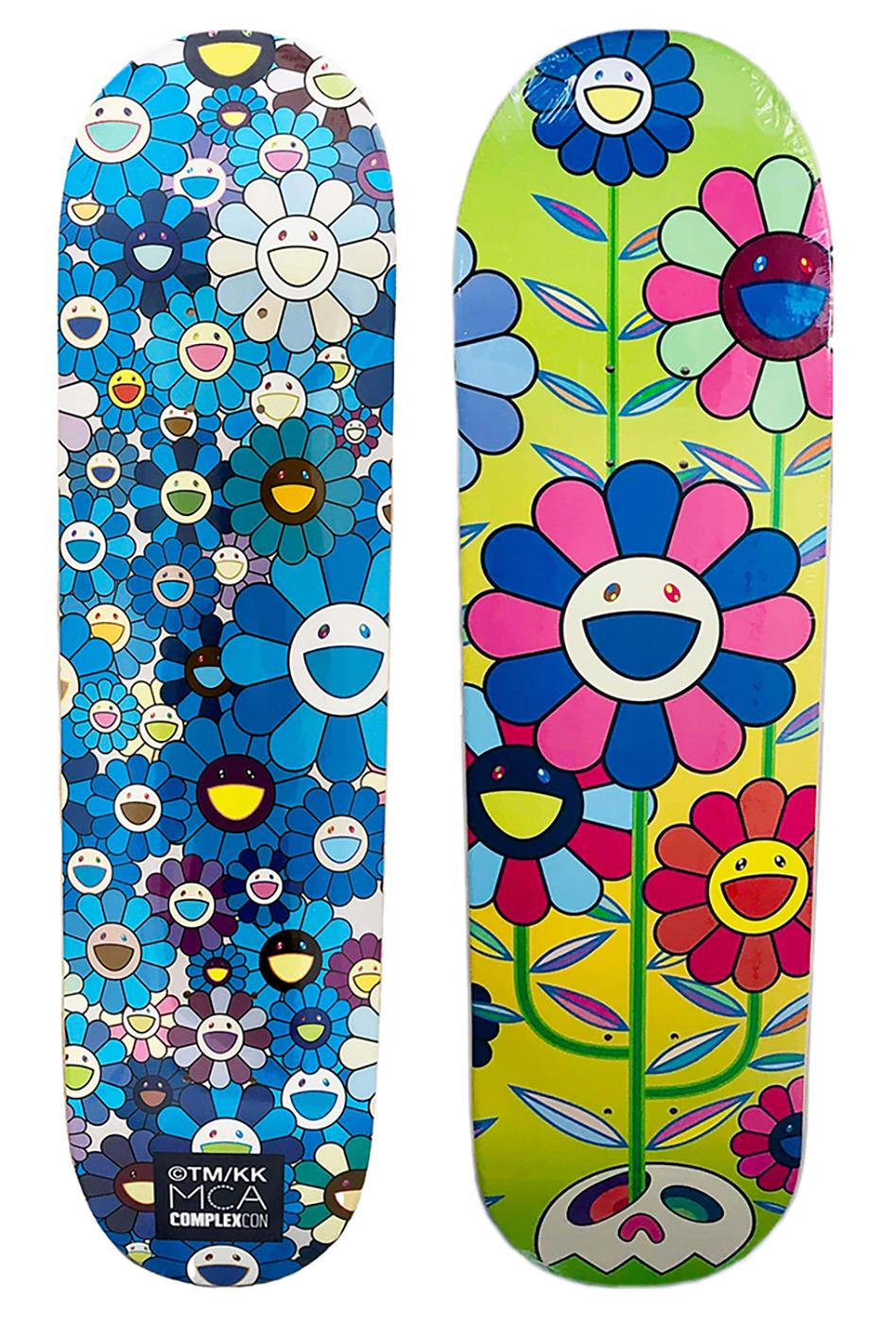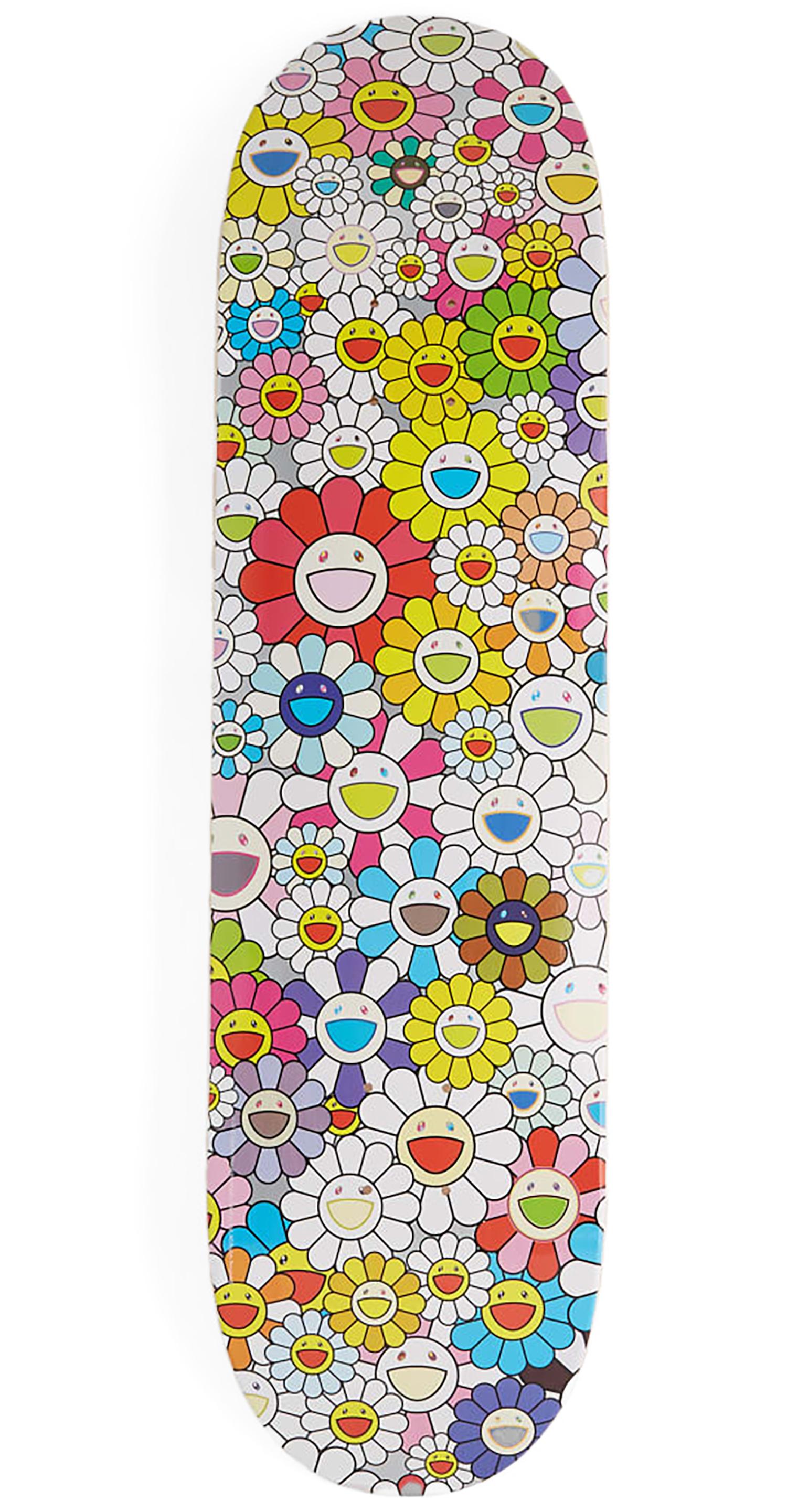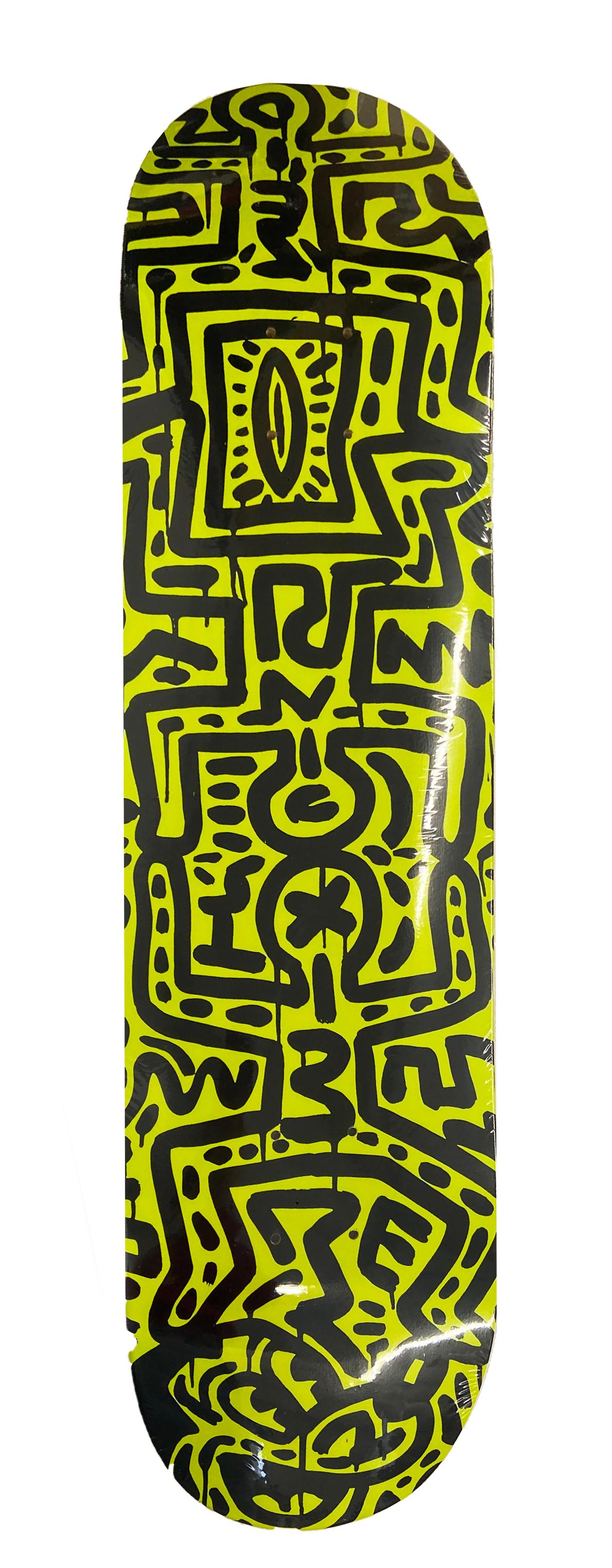Items Similar to Gilbert & George Supreme skateboard decks: set of 3 (Gilbert & George pictures)
Want more images or videos?
Request additional images or videos from the seller
1 of 2
Gilbert & GeorgeGilbert & George Supreme skateboard decks: set of 3 (Gilbert & George pictures)2019
2019
About the Item
Complete Set of 3 Gilbert & George Supreme Skateboard Decks (New in original packaging):
A stand out skate triptych paying homage to Gilbert & George's 1984 Pictures series, through which Gilbert & George applied bold colors to a series of photographs developed in the ‘70s. The photomontages address issues involving religion, race, corruption, illness, and death.
Dimensions: 31.5 x 8 x 0.5 in. (applies to each individual)
Medium: Silkscreen on Maple Wood.
Year: 2019.
Printed artist signature & Supreme logo on reverse (on all 3).
New in original packaging, excellent overall condition.
Provenance: Acquired directly from Supreme New York.
From a sold out limited edition of unknown.
British artists Gilbert & George met in 1967 while studying at St. Martin’s School of Art. While their work is rooted in sculpture and performance, it has evolved over the years to include photography, drawing, painting, and film.
Supreme’s love of Pop Art is well noted and Gilbert & George’s work has earned consistent comparisons with Andy Warhol. And while there are clear visual consistencies between Warhol’s Polaroid series and The 1984 pictures it’s a charge the duo reject, dismissing the American artist as a commercialist.
Related Categories
Damien Hirst. Andy Warhol. Supreme. 1980s Pop Art. Street Art. Skate Art.
- Creator:Gilbert & George (1942, British)
- Creation Year:2019
- Dimensions:Height: 31.5 in (80.01 cm)Width: 8 in (20.32 cm)
- Medium:
- Movement & Style:
- Period:
- Condition:
- Gallery Location:NEW YORK, NY
- Reference Number:1stDibs: LU35434730121
About the Seller
5.0
Vetted Seller
These experienced sellers undergo a comprehensive evaluation by our team of in-house experts.
Established in 2014
1stDibs seller since 2016
4,241 sales on 1stDibs
Typical response time: <1 hour
- ShippingRetrieving quote...Ships From: New York, NY
- Return PolicyThis item cannot be returned.
More From This SellerView All
- Takashi Murakami Skateboard Deck (Murakami Flowers)By Takashi MurakamiLocated in NEW YORK, NYTakashi Murakami Flowers Skateboard Deck: A collaboration between Takashi Murakami and his friend, the rising Japanese artist 'Madsaki' (bio below). The impression is an urban twist...Category
21st Century and Contemporary Pop Art Animal Prints
MaterialsWood, Lithograph, Screen
- Keith Haring Skateboard Deck (Keith Haring dragon)By (after) Keith HaringLocated in NEW YORK, NYKeith Haring Skateboard Deck c.2012: Rare, out of print Keith Haring skate deck featuring one of the artist's iconic dragon images, set amidst a vibrant array of colors that really p...Category
1980s Pop Art Sculptures
MaterialsWood, Screen, Lithograph
- Basquiat Keith Haring skateboard decks (set of 2 works)By after Jean-Michel BasquiatLocated in NEW YORK, NYJean-Michel Basquiat & Keith Haring Skateboard Decks (set of 2 individual works): A standout Basquiat & Keith Haring Skateboard Deck set - with each piece trademark by their respective estates. Features classic early 1980s Keith Haring Mickey...Category
1980s Pop Art Prints and Multiples
MaterialsWood, Epoxy Resin, Lithograph
- Takashi Murakami Flowers Skateboard Decks: set of 2 works (Murakami skateboard)By Takashi MurakamiLocated in NEW YORK, NYTakashi Murakami Flowers Skateboard Decks: set of 2 works: A vibrant, highly decorative Takashi Murakami skateboard set produced as a limited series in conjunction with the 2017 Mura...Category
1980s Pop Art Prints and Multiples
MaterialsOffset, Wood
- Takashi Murakami Flowers skateboard deck (Takashi Murakami skate deck)By Takashi MurakamiLocated in NEW YORK, NYTakashi Murakami Flowers Skateboard Deck 2015: A vibrant, unique piece of Takashi Murakami flowers wall-art - this highly collectible limited edition Murakami skate...Category
1980s Pop Art Prints and Multiples
MaterialsOffset, Wood
- Keith Haring Skateboard Deck (Keith Haring Mickey Mouse)By (after) Keith HaringLocated in NEW YORK, NYKeith Haring Mickey Mouse Skateboard Deck: Standout Keith Haring Skateboard Deck featuring lush, vibrant, fun colors & classic early 1980s Keith Haring Mickey Mouse imagery. A brilli...Category
1980s Pop Art Sculptures
MaterialsWood, Offset
You May Also Like
- James Rosenquist F-111 TRIPTYCH (GIRL) Limited Skate Modern Design Pop AmericanBy James RosenquistLocated in Madrid, MadridJames Rosenquist F-111 TRIPTYCH A (GIRL) Date of creation: 2021 Medium: Digital print on Canadian maple wood Edition: 100 Size: 80 x 20 cm (each skate...Category
2010s Pop Art Abstract Prints
MaterialsWood, Maple, Screen
- Bureau of Public Works (Mixed Media on Wood) Twice Signed Artists Proof Ed of 2By Shepard FaireyLocated in New York, NYSHEPARD FAIREY Bureau of Public Works (on Wood), 2004 Mixed media silkscreen on wood panel. Hand signed and annotated on both the recto and verso. In original handmade artist's frame...Category
Early 2000s Pop Art Mixed Media
MaterialsWood, Mixed Media, Screen, Pencil
- The Appropriation piece: Andy Warhol, Frank Stella, Roy Lichtenstein Unique var.By Richard PettiboneLocated in New York, NYRichard Pettibone The Appropriation Print Andy Warhol, Frank Stella, Roy Lichtenstein, 1970 Silkscreen in colors on masonite board (unique variant on sculpted board) Hand-signed by artist, Signed and dated on the front (see close up image) Bespoke frame Included This is a rare example of Pettibone's iconic Appropriation Print, as it's silkscreened and sculpted on masonite board rather than paper, giving it a different background hue, and enabling it work to be framed so uniquely. The Appropriation print is one of the most coveted prints Pettibone ever created ; the regular edition is on a full sheet with white background; the present example was silkscreened on board, allowing it to be framed in 3-D. While we do not know how many examples of this graphic work Pettibone created, so far the present work is the only one example we have ever seen on the public market since 1970. (Other editions of The Appropriation Print have been printed on vellum, wove paper and pink and yellow paper.) This 1970 homage to Andy Warhol, Frank Stella and Roy Lichtenstein exemplifies the type of artistic appropriation he was engaging in early on during the height of the Pop Art movement - long before more contemporary artists like Deborah Kass, Louise Lawler, etc. followed suit. This silkscreen was in its original 1970 vintage period frame; a bespoke custom hand cut black wood outer frame was subsequently created especially to house the work, giving it a distinctive sculptural aesthetic. Measurements: Framed 14.5 inches vertical by 18 inches horizontal by 2 inches Work 13 inches vertical by 16.5 inches horizontal Richard Pettibone biography: Richard Pettibone (American, b.1938) is one of the pioneering artists to use appropriation techniques. Pettibone was born in Los Angeles, and first worked with shadow boxes and assemblages, illustrating his interest in craft, construction, and working in miniature scales. In 1964, he created the first of his appropriated pieces, two tiny painted “replicas” of the iconic Campbell’s soup cans by Andy Warhol (American, 1928–1987). By 1965, he had created several “replicas” of paintings by American artists, such as Warhol, Roy Lichtenstein (1923–1997), Ed Ruscha (b.1937), and others, among them some of the biggest names in Pop Art. Pettibone chose to recreate the work of leading avant-garde artists whose careers were often centered on themes of replication themselves, further lending irony to his work. Pettibone also created both miniature and life-sized sculptural works, including an exact copy of Bicycle Wheel by Marcel Duchamp (French, 1887–1968), and in the 1980s, an entire series of sculptures of varying sizes replicating the most famous works of Constantin Brancusi (Romanian, 1876–1957). In more recent years, Pettibone has created paintings based on the covers of poetry books by Ezra Pound, as well as sculptures drawn from the grid compositions of Piet Mondrian (Dutch, 1872–1944). Pettibone straddles the lines of appropriation, Pop, and Conceptual Art, and has received critical attention for decades for the important questions his work raises about authorship, craftsmanship, and the original in art. His work has been exhibited at the Institute for Contemporary Art in Philadelphia, the Museum of Modern Art in New York, the Museum of Contemporary Art in Miami, and the Laguna Art Museum in Laguna Beach, CA. Pettibone is currently based in New York. "I wished I had stuck with the idea of just painting the same painting like the soup can and never painting another painting. When someone wanted one, you would just do another one. Does anybody do that now?" Andy Warhol, 1981 Since the mid-1960s, Richard Pettibone has been making hand-painted, small-scale copies of works by other artists — a practice due to which he is best known as a precursor of appropriation art — and for a decade now, he has been revisiting subjects from across his career. In his latest exhibitions at Castelli Gallery, Pettibone has been showing more of the “same” paintings that had already been part of his 2005–6 museum retrospective,1 and also including “new” subject matter drawn from his usual roster of European modernists and American postwar artists. Art critic Kim Levin laid out some phases of the intricate spectrum from copies to repetitions in her review of the Warhol-de Chirico showdown, a joint exhibition at the heyday of appropriation art in the mid-1980s when Warhol’s appropriations of de Chirico’s work effectively revaluated “the grand old auto-appropriator”. Upon having counted well over a dozen Disquieting Muses by de Chirico, Levin speculated: “Maybe he kept doing them because no one got the point. Maybe he needed the money. Maybe he meant it when he said his technique had improved, and traditional skills were what mattered.” On the other side, Warhol, in her eyes, was the “latter-day exemplar of museless creativity”. To Pettibone, traditional skills certainly still matter, as he practices his contemporary version of museless creativity. He paints the same painting again and again, no matter whether anybody shows an interest in it or not. His work, of course, takes place well outside the historical framework of what Levin aptly referred to as the “modern/postmodern wrestling match”, but neither was this exactly his match to begin with. Pettibone is one of appropriation art’s trailblazers, but his diverse selection of sources removes from his work the critique of the modernist myth of originality most commonly associated with appropriation art in a narrow sense, as we see, for example, in Sherrie Levine’s practice of re-photographing the work of Walker Evans and Edward Weston. In particular, during his photorealist phase of the 1970s, Pettibone’s sources ranged widely across several art-historical periods. His appropriations of the 1980s and 1990s spanned from Picasso etchings and Brancusi sculptures to Shaker furniture and even included Ezra Pound’s poetry. Pettibone has professed outright admiration for his source artists, whose work he shrinks and tweaks to comic effect but, nevertheless, always treats with reverence and care. His response to these artists is primarily on an aesthetic level, owing much to the fact that his process relies on photographs. By the same token, the aesthetic that attracts him is a graphic one that lends itself to reproduction. Painstakingly copying other artists’ work by hand has been a way of making it his own, yet each source is acknowledged in his titles and, occasionally, in captions on white margins that he leaves around the image as an indication that the actual source is a photographic image. The enjoyment he receives in copying is part of the motivation behind doing it, as is the pleasure he receives from actually being with the finished painting — a considerable private dimension of his work. His copies are “handmade readymades” that he meticulously paints in great quantities in his studio upstate in New York; the commitment to manual labor and the time spent at material production has become an increasingly important dimension of his recent work. Pettibone operates at some remove from the contemporary art scene, not only by staying put geographically, but also by refusing to recoup the simulated lack of originality through the creation of a public persona. In so doing, Pettibone takes a real risk. He places himself in opposition to conceptualism, and he is apprehensive of an understanding of art as the mere illustration of an idea. His reading of Marcel Duchamp’s works as beautiful is revealing about Pettibone’s priorities in this respect. When Pettibone, for aesthetic pleasure, paints Duchamp’s Poster...Category
1970s Pop Art Mixed Media
MaterialsMasonite, Pencil, Screen, Mixed Media
- With all My Flowering Heart Skateboard Triptych, 3 Limited Edition Skate DecksBy Yayoi KusamaLocated in New York, NYYayoi Kusama With All My Flowering Heart (Triptych), 2014 Set of Three (3) Separate Limited Edition numbered skate decks on 7-ply Canadian maple wood 31 × 8 × 2/5 inches (each) Hand ...Category
2010s Pop Art Mixed Media
MaterialsWood, Mixed Media, Permanent Marker, Screen
- Beautiful, Everlasting, Inexhaustibly Interesting, Revelatory Gyration paintingBy Damien HirstLocated in New York, NYDamien Hirst H12-4: Beautiful, Everlasting, Inexhaustibly Interesting, Self-Revelatory Gyration Painting, 2023 Mixed Media Giclée print on poly-cotton artist canvas mounted on a birc...Category
2010s Pop Art Abstract Prints
MaterialsPlywood, Mixed Media, Acrylic, Giclée
- Girl and Boy Shopping, Carved Wood Wall Sculpture by David BromleyBy David BromleyLocated in Long Island City, NYArtist: David Bromley, British/Australian (1960 - ) Title: Girl and Boy Shopping Year: circa 2010 Medium: Wood Collage Multiple, signed in pencil Edition: AP Size: 11.5 x 15.5 in. ...Category
Early 2000s Pop Art Figurative Prints
MaterialsWood, Acrylic
Recently Viewed
View AllMore Ways To Browse
Skateboard Art Decks
Warhol Skateboard
Andy Warhol Skateboard
Skateboard Set
Black Art Skateboard Art
Warhol Skateboard Deck
Skateboard Deck Andy Warhol
Triptych Street Art
Damien Hirst Skateboard
Skateboarding Photography
Skateboard Photography
Supreme Deck
Supreme Skateboard
Supreme Skate
Supreme Skate Deck
Gilbert & George On Sale
Antique Botanical Prints Prints
Antique Botanical Prints

